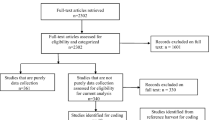Abstract
Objectives
Recent decades have seen a focus on intervention programs to reduce school bullying, in light of the severe negative consequences of such behavior. A recent meta-analysis by Ttofi and Farrington (Journal of Experimental Criminology 7: 27–56, 2011) provided encouraging findings in terms of some significant reductions in bullying and victimization achieved by many programs. They also report analyses of effect sizes associated with specific program elements and design features of the interventions. While this is an important step forward, we critique some of the strong policy implications which they draw from these latter analyses.
Methods
We discuss four important areas to substantiate this critique: analytical procedure, definitional issues, historical issues, and recent empirical data. As context, we use two particular program elements described by Ttofi and Farrington, namely use of disciplinary measures and work with peers, and one design feature, namely age of pupils.
Results
The findings for the program elements and design feature examined are complex and do not justify strong policy implications at this stage.
Conclusions
We conclude with suggestions for future research directions.
Similar content being viewed by others
References
Arseneault, L., Bowes, L., & Shakoor, S. (2009). Bullying victimization in youths and mental health problems: “much ado about nothing”? Psychological Medicine, 29, 1–13.
Cook, C. R., Williams, K. R., Guerra, N. G., & Kim, T. E. (2010). Variability in the prevalence of bullying and victimization: A cross-national and methodological analysis. In S. R. Jimerson, S. M. Swearer, & D. L. Espelage (Eds.), Handbook of bullying in schools: An international perspective (pp. 347–362). New York: Routledge.
Cowie, H., & Oztug, O. (2008). Pupils’ perceptions of safety at school. Pastoral Care in Education, 26, 59–67.
Cowie, H., & Smith, P. K. (2010). Peer support as a means of improving school safety and reducing bullying and violence. In B. Doll, W. Pfohl, & J. Yoon (Eds.), Handbook of prevention research (pp. 177–193). New York: Routledge.
Cowie, H., Hutson, N., Oztug, O., & Myers, C. (2008). The impact of peer support schemes on pupils’ perceptions of bullying, aggression and safety at school. Emotional and Behavioural Difficulties, 13, 63–71.
Garandeau, C. F., Little, T., Kärnä, A., Poskiparta, E., & Salmivalli, C. (2011). Dealing with bullies at school: which approach for which situations? In M. Sainio & C. F. Garandeau (Chairs), KiVa anti-bullying program: Practical viewpoints on implementation and effectiveness, and an innovative perspective from social network analysis. Symposium presented at the Biennial Meeting of the European Society for Developmental Psychology, Bergen, Norway.
Gini, G., & Pozzoli, T. (2009). Association between bullying and psychosomatic problems: A metaanalysis.Pediatrics, 123, 1059–1065.
Kärnä, A., Voeten, M., Little, T., Alanen, E., Poskiparta, E., & Salmivalli, C. (2011a). Effectiveness of the KiVa antibullying program: Grades 1–3 and 7–9. Under review.
Kärnä, A., Voeten, M., Little, T., Alanen, E., Poskiparta, E., & Salmivalli, C. (2011b). Going to scale: a nonrandomized nationwide trial of the KiVa antibullying program for comprehensive schools. Journal of Consulting and Clinical Psychology. doi:10.1037/a0025740.
Kärnä, A., Voeten, M., Little, T., Poskiparta, E., Kaljonen, A., & Salmivalli, C. (2011c). A large scale evaluation of the KiVa antibullying program: grades 4–6. Child Development, 82, 311–330.
McCluskey, G., Lloyd, G., Kane, J., Riddell, S., Stead, J., & Weedon, E. (2008). Can restorative practices in schools make a difference? Educational Review, 60, 405–417.
Monks, C. P. (2011). Peer victimisation in preschool. In C. Monks & I. Coyne (Eds.), Bullying in different contexts (pp. 12–35). Cambridge: Cambridge University Press.
Morrison, B. (2007). Restoring safe school communities: A whole school response to bullying, violence and alienation. Sydney: The Federation Press.
Olweus, D., & Limber, S. P. (2010). Bullying in school: evaluation and dissemination of the Olweus Bullying Prevention Progam. American Journal of Orthopsychiatry, 80, 124–134.
Poskiparta, E., Kaukiainen, A., Pöyhönen, V., & Salmivalli, C. (2012). Anti-bullying computer game as part of the KiVa program: Students’ perceptions of the game. In A. Costabile & B. Spears (Eds.), The impact of technology on relationships in educational settings: International perspectives. New York: Routledge.
Sapouna, M., Wolke, D., Vannani, N., Watson, S., Woods, S., Schneider, W., Enz, S., Hall, L., Paiva, A., Andre, E., Dautenhahn, K., & Aylett, R. (2009). Virtual learning intervention to reduce bullying victimization in primary school: a controlled trial. Journal of Child Psychology and Psychiatry, 51, 104–112.
Skiba, R., Reynolds, C. R., Graham, S., Sheras, P., Conoley, J. C., & Garcia-Vasquez, E. (2006). Are zero tolerance policies effective in the schools? An evidentiary review and recommendations. A Report by the American Psychological Association Zero Tolerance Taskforce. Retrieved from http://www.apa.org/ed/cpse/zttfreport.pdf.
Smith, P. K. (2010). Cyberbullying: the European perspective. In: J. Mora-Merchán & T. Jäger (Eds). Cyberbullying: A cross-national comparison. (pp. 7–19). Landau: Empirische Pädagogik.
Smith, P. K., Morita, Y., Junger-Tas, J., Olweus, D., Catalano, R., & Slee, P. (Eds.). (1999). The nature of school bullying: A cross-national perspective. New York: Routledge.
Spiel, C., Salmivalli, C., & Smith, P. K. (2011). Translational research: national strategies for violence prevention in school. International Journal of Behavioral Development, 35, 381–382.
Thompson, F., & Smith, P. K. (2011). The use and effectiveness of anti-bullying strategies in schools. Research Brief DFE-RB098. https://www.education.gov.uk/publications/RSG/AllRsgPublications/Page10/DFE-RR098.
Ttofi, M. M., & Farrington, D. P. (2008). Reintegrative shaming theory, moral emotions and bullying. Aggressive Behavior, 34, 352–368.
Ttofi, M. M., & Farrington, D. P. (2011). Effectiveness of school-based programs to reduce bullying: a systematic and meta-analytic review. Journal of Experimental Criminology, 7, 27–56.
Ttofi, M. M., Farrington, D. P., & Lösel, F. (2011). Editorial: health consequences of school bullying. Journal of Aggression, Conflict and Peace Research, 3, 60–62.
United Nations (1989). Convention on the Rights of the Child. Geneva, Switzerland: Office of the United Nations High Commissioner for Human Rights. Retrieved March, 9, 2007, from http://www.unicef.org/crc.
Author information
Authors and Affiliations
Corresponding author
Rights and permissions
About this article
Cite this article
Smith, P.K., Salmivalli, C. & Cowie, H. Effectiveness of school-based programs to reduce bullying: a commentary. J Exp Criminol 8, 433–441 (2012). https://doi.org/10.1007/s11292-012-9142-3
Published:
Issue Date:
DOI: https://doi.org/10.1007/s11292-012-9142-3




